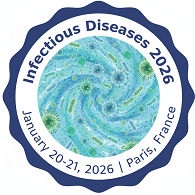About Conference
The 7th Annual Meeting on Infectious Diseases, Microbiology & Beneficial Microbes invites global participants to join this esteemed international gathering, scheduled for January 20–21, 2026, in Paris, France. This dynamic event will bring together leading researchers, clinicians, microbiologists, and public health professionals for two days of keynote presentations, oral talks, poster sessions, and interactive discussions.
Theme: Innovative Approaches to Combat Infectious Threats and Harness Beneficial Microbes for Global Health
This annual conference serves as a vibrant platform to showcase cutting-edge research and foster collaboration across disciplines, addressing the prevention, diagnosis, and treatment of infectious diseases that affect people of all ages and backgrounds worldwide.
Infectious diseases are caused by harmful microorganisms such as bacteria, viruses, fungi, and parasites. While many microbes naturally inhabit our bodies without harm and often provide benefits certain conditions can enable them to cause infections. The field of microbiology explores these microorganisms, advancing knowledge in cell biology, biochemistry, genetics, and host-pathogen interactions.
A key focus of this year’s meeting is emerging infectious diseases, including global threats such as COVID-19, Zika virus, and Ebola. Sessions will explore how environmental, ecological, and socio-economic factors contribute to disease emergence. Experts will discuss global strategies for early detection, real-time surveillance, and the rapid containment of new and re-emerging pathogens.
Join us in Paris to gain valuable insights, share your expertise, and contribute to shaping the future of infectious disease control and microbial science. Be part of the conversation driving innovation in global health.
Why To Attend
Join us for the 7th Annual Meeting on Infectious Diseases, Microbiology & Beneficial Microbes, scheduled for January 20–21, 2026, in Paris, France. Centered around the theme "Innovative Approaches to Combat Infectious Threats and Harness Beneficial Microbes for Global Health," this international gathering promises a rich and engaging program, including keynote lectures, oral presentations, poster sessions, and thought-provoking discussions.
Esteemed researchers, educators, clinicians, and professionals from around the globe will share their latest findings, offering insights into how diverse populations can be protected and treated against infectious diseases through innovative science and collaboration.
Here’s why you should attend:
Cutting-edge research: Discover the most recent advances and scientific breakthroughs in infectious disease management, microbiology, and beneficial microbes.
Networking opportunities: Meet and engage with peers, researchers, and global experts to foster new collaborations and strengthen your professional network.
Multidisciplinary insights: Explore a broad range of topics including microbial interactions, diagnostics, clinical microbiology, and public health, offering a well-rounded understanding of the current landscape.
Real-world applications: Gain exposure to practical strategies and innovative tools that are making a real difference in controlling infectious diseases and promoting health.
Professional growth: Enhance your knowledge, contribute to important conversations, and establish your presence in the fields of microbiology and infectious disease research.
Don’t miss the opportunity to be part of this forward-thinking conference. Join us in Paris to help shape the future of infectious disease science and microbial innovation. Register early to ensure your place at this impactful event.
Sessions & Tracks
Track 1: Bacterial Infections and Diseases
Bacterial infections occur when harmful bacteria invade the body, leading to various health issues. Bacteria are microscopic, single-celled organisms that can inhabit diverse environments and can be both beneficial and harmful. Pathogenic bacteria can cause illness by producing toxins, attacking cells, and triggering immune responses.
-
Gram-positive bacteria: These have a thick cell wall. Notable examples include Staphylococcus aureus, which causes skin infections and pneumonia, and Streptococcus pyogenes, responsible for strep throat and skin infections.
-
Gram-negative bacteria: These have a thinner cell wall. Examples include Escherichia coli, which causes UTIs and gastrointestinal infections, and Salmonella, known for causing food poisoning.
-
Anaerobic bacteria: These bacteria can survive without oxygen and are often found in deep wounds and the gastrointestinal tract. Examples include Clostridium difficile, which causes severe diarrhea, and Bacteroides fragilis, leading to intra-abdominal infections.
Common bacterial diseases:
-
Tuberculosis (TB): Caused by Mycobacterium tuberculosis, TB primarily affects the lungs but can also impact other body parts. Symptoms include coughing, chest pain, fever, fatigue, and weight loss.
-
Urinary tract infection (UTI): Often caused by Escherichia coli, UTIs can also be caused by other bacteria. Symptoms include frequent urination, pain during urination, cloudy or bloody urine, and pelvic pain.
-
Salmonellosis: Caused by various strains of Salmonella, salmonellosis is typically contracted from contaminated food or water, with symptoms including diarrhea, fever, abdominal cramps, nausea, and vomiting.
Track 2: Viral Infections and Diseases
Viral infections are caused by viruses, tiny infectious agents that replicate inside living cells. Viruses can infect humans, animals, plants, and bacteria.
-
Influenza (flu): A highly contagious respiratory infection with symptoms including fever, cough, sore throat, muscle aches, and fatigue.
-
Ebola virus disease: A severe, often fatal illness with symptoms such as fever, headache, muscle pain, fatigue, diarrhea, vomiting, and bleeding.
-
Zika virus infection: Spread by Aedes mosquitoes, causing mild symptoms like fever, rash, and joint pain, with potential birth defects if contracted during pregnancy.
-
Herpes: Caused by HSV-1 and HSV-2, leading to painful sores, itching, and flu-like symptoms.
Track 3: Fungal Infections
Fungal infections are caused by fungi, microorganisms that can lead to a variety of diseases affecting different parts of the body. Fungi are widespread in the environment and can invade the body, causing health issues.
-
Athlete's foot (tinea pedis): This common fungal infection primarily affects the feet, causing itching, burning, redness, and peeling of the skin, especially between the toes.
-
Ringworm (tinea corporis): Ringworm is a fungal infection that can appear anywhere on the body. It is characterized by a red, ring-shaped rash with clear skin in the center, which may be itchy or painful.
-
Yeast infections: Caused by an overgrowth of Candida fungi, including Candida albicans, yeast infections can affect the mouth (oral thrush), genitals (vaginal yeast infection), and skin folds. Symptoms typically include itching, redness, swelling, and white discharge.
Track 4: Parasitic Infections
Parasitic infections are caused by parasites, organisms that live on or inside a host and rely on it for nourishment and survival. These parasites can include protozoa, helminths (worms), or ectoparasites like ticks and lice. Infections can occur through contaminated food or water, insect bites, or contact with contaminated soil.
-
Malaria: Caused by the Plasmodium parasite and transmitted by infected female Anopheles mosquitoes. Symptoms include fever, chills, and flu-like symptoms, which can be life-threatening without prompt treatment.
-
Toxoplasmosis: Caused by the Toxoplasma gondii parasite, commonly found in cat feces. It can be contracted through contaminated food or water and may cause flu-like symptoms or severe complications, especially in pregnant women and immunocompromised individuals.
-
Tapeworm infections: Result from various species of tapeworms, often through undercooked or contaminated meat. Symptoms can include abdominal pain, weight loss, and nutritional deficiencies.
Track 5: Prion Diseases
Prion diseases, or transmissible spongiform encephalopathies (TSEs), are rare, progressive neurodegenerative disorders caused by abnormal prion proteins. Unlike other pathogens, prions lack DNA or RNA.
-
Creutzfeldt-Jakob disease (CJD): The most common prion disease in humans, presenting in sporadic, familial, or acquired forms. Symptoms include rapid dementia, muscle stiffness, involuntary movements, and eventually coma and death.
-
Variant Creutzfeldt-Jakob disease (vCJD): Associated with consuming prion-contaminated beef, particularly from bovine spongiform encephalopathy (BSE), or mad cow disease. It has a younger onset age and may present with psychiatric symptoms.
-
Gerstmann-Sträussler-Scheinker syndrome (GSS): A rare inherited prion disease causing ataxia, dementia, and other neurological symptoms, linked to mutations in the prion protein gene (PRNP).
-
Fatal familial insomnia (FFI): An inherited prion disease marked by progressive insomnia, autonomic dysfunction, and dementia, also caused by mutations in the PRNP gene.
Currently, prion diseases have no cure and are invariably fatal. Treatment focuses on symptom management and supportive care. Prevention includes avoiding contaminated meat and implementing stringent infection control in healthcare settings.
Track 6: Probiotics and Prebiotics
Probiotics and prebiotics both support gut health but function differently. Probiotics are live microorganisms, typically bacteria or yeast, that confer health benefits when consumed in adequate amounts. These beneficial microbes are similar to those naturally found in the gut and are present in foods like yogurt, kefir, sauerkraut, kimchi, and in supplement form. They help maintain a healthy gut flora by encouraging the growth of beneficial bacteria and suppressing harmful ones. Probiotics have been linked to improved digestion, enhanced immune function, relief from irritable bowel syndrome (IBS), and even mental health support.
Prebiotics, on the other hand, are types of fiber that nourish beneficial gut bacteria. They are not digested by the human body but pass through to the colon, where they are fermented by gut bacteria, producing short-chain fatty acids that fuel colon cells and support gut health. Found in foods like bananas, onions, garlic, leeks, asparagus, chicory root, and whole grains, prebiotics work synergistically with probiotics to promote overall well-being.
Track 7: Biofertilizers
Biofertilizers are substances containing living microorganisms that enhance plant growth by improving the availability of essential nutrients. They offer an eco-friendly alternative to chemical fertilizers by utilizing natural processes such as nitrogen fixation, phosphorus solubilization, and potassium mobilization.
-
Nitrogen-fixing biofertilizers: These include bacteria like Rhizobium, Azotobacter, Azospirillum, and cyanobacteria, which convert atmospheric nitrogen into ammonia usable by plants. They are especially beneficial for leguminous crops such as soybeans, peas, and beans.
-
Phosphorus-solubilizing biofertilizers: Containing microorganisms like Bacillus and Pseudomonas bacteria, and fungi such as Aspergillus and Penicillium, these biofertilizers solubilize insoluble phosphorus in the soil, making it available to plants.
-
Potassium-mobilizing biofertilizers: These include microorganisms like Bacillus mucilaginosus and fungi like Aspergillus niger, which help mobilize potassium in the soil, enhancing its accessibility to plants.
Track 8: Gene Expression
Gene expression is the process by which information from a gene is used to synthesize a functional gene product, typically proteins or RNA molecules. It involves several key steps:
-
Transcription: In the nucleus, DNA unwinds, and RNA polymerase binds to the promoter region of a gene to synthesize messenger RNA (mRNA). This mRNA carries genetic information from the DNA to the cytoplasm.
-
RNA processing (in eukaryotes): Pre-mRNA undergoes modifications including capping (adding a 5' cap), splicing (removing introns), and polyadenylation (adding a poly-A tail).
-
Translation: In the cytoplasm, ribosomes read the mRNA sequence and translate it into a polypeptide chain. Transfer RNA (tRNA) molecules bring amino acids to the ribosome.
Gene expression is tightly regulated by environmental signals, developmental cues, and cellular pathways. Dysregulation can lead to diseases such as cancer and genetic disorders.
Track 9: Mutations
Mutations are changes in the DNA sequence of an organism's genome and can have varying effects. Some mutations may be harmless or beneficial, while others can lead to genetic disorders or increase disease risk. Examples include mutations that cause cystic fibrosis, sickle cell disease, and Huntington's disease. Accumulation of mutations in dividing cells can also lead to cancer. Despite potential negative effects, mutations are essential for evolution. Research continues into understanding mutations and developing therapies for genetic diseases.
Track 10: Sexually Transmitted Diseases (STDs) and Infections (STIs)
Sexually transmitted diseases (STDs) and infections (STIs) are infections commonly spread through sexual activities. They can be caused by bacteria, viruses, parasites, or fungi.
-
Chlamydia: Caused by Chlamydia trachomatis.
-
Gonorrhea: Caused by Neisseria gonorrhoeae.
-
Syphilis: Caused by Treponema pallidum.
-
Human papillomavirus (HPV): Can cause genital warts and cancers.
-
Herpes simplex virus (HSV): Causes genital herpes.
-
HIV/AIDS: Weakens the immune system.
Prevention includes safe sex practices, regular testing, and early treatment.
Track 11: COVID-19
COVID-19 is caused by SARS-CoV-2, first identified in Wuhan, China in 2019. It spreads through respiratory droplets and contact with contaminated surfaces. Symptoms include fever, cough, and fatigue, with severe cases leading to respiratory distress and death. Public health measures include masks, distancing, handwashing, and vaccination. The pandemic has had global health, economic, and societal impacts.
Track 12: Antigen-Antibody Reactions
Antigen-antibody reactions are crucial to the immune response. Antigens trigger immune responses, while antibodies are proteins that recognize and bind to specific antigens. These reactions are key in immunity, diagnostics, allergy, and autoimmune responses. They are foundational in vaccine and diagnostic test development.
Track 13: Advancements in Vaccines and Therapeutics
Recent developments include mRNA vaccines like Pfizer-BioNTech and Moderna, and vector-based vaccines like Oxford-AstraZeneca. These innovations allow rapid response to emerging pathogens. Advances also include monoclonal antibodies and antiviral drugs. These tools improve prevention and treatment of infectious diseases.
Track 14: Infectious Diseases and Cancer
Infectious diseases result from bacteria, viruses, parasites, or fungi. Prevention includes vaccines, hygiene, and vector control. Cancer involves uncontrolled cell growth due to genetic and environmental factors. Treatment includes surgery, chemotherapy, radiation, and immunotherapy. Infections such as HPV and hepatitis B/C are linked to cancer development.
Track 15: Veterinary Infectious Diseases
These affect animals and can be zoonotic. Examples include:
-
Canine distemper: Viral disease in dogs.
-
Feline panleukopenia: Viral infection in cats.
-
Rabies: A fatal viral disease transmissible to humans.
-
Foot-and-mouth disease (FMD): Viral disease in livestock.
-
Control includes vaccination, biosecurity, and veterinary care.
Abstract Submission Criteria & Eligibility
Presentation Guidelines
All presenting authors are required to complete their own registration and cover associated travel and accommodation expenses. Upon abstract acceptance, authors will receive an official acceptance email, which will enable them to proceed with registration. All accepted abstracts will be compiled in the official conference book, available to attendees during the event.
If a presenter becomes unavailable, it is their responsibility to arrange for a qualified substitute to deliver the presentation. Any such changes must be communicated to the conference team in advance.
Submission Categories
-
Oral Presentations: Each presenter will be allocated a 30-minute time slot. Presentations will be grouped into theme-specific sessions.
-
Keynote Presentations: Allotted a 45-minute session to deliver high-level, impactful content.
Workshops, Special Sessions & Symposiums: Scheduled for 60 minutes with an additional 5 minutes for audience Q&A in symposiums.
-
Graduate & Master’s Students: Invited to submit abstracts for poster or e-poster presentations.
-
PhD Students: Eligible to submit abstracts under the Young Researchers’ Forum (YRF), as well as for poster and e-poster presentations. YRF sessions will feature brief oral presentations designed specifically for doctoral researchers.
-
Extended Abstracts: Must follow the official Abstract Template and may include original empirical studies, theoretical contributions, literature reviews, or critical analyses.
Participation / Presentation option
Oral Presentation
Oral presentations may focus on research outcomes, theoretical advancements, practical applications, or personal experiences that offer valuable perspectives. Each speaker will be allocated a 30-minute slot, with 20–25 minutes dedicated to the presentation and the remaining time reserved for audience Q&A, moderated by the Session Chair. Keynote speakers are provided 45 minutes, with 40–45 minutes for their talk and the balance for interaction with attendees.
Workshop
Workshops provide an in-depth look into specific topics through practical demonstrations and interactive sessions. Typically lasting 45–50 minutes, these sessions are ideal for presenters aiming to deliver hands-on learning or detailed insights beyond a standard oral presentation. Collaborative workshop teams may be eligible for special group registration benefits. Coordination with research organizers is encouraged.
Poster Presentation
The Student Poster Competition at Infectious Diseases 2026 encourages students and recent graduates to present original research. Each participant will have 5–7 minutes to explain their poster, followed by a Q&A with evaluators. This platform enables young researchers to engage with interdisciplinary work and improve their presentation skills. Posters should be printed in hard copy format, sized at 1 x 1 meter.
Webinar Presentation
For presenters unable to attend in person, webinar sessions offer an effective alternative. Recorded presentations will be included in the conference’s virtual program, allowing remote participants to access the content asynchronously during the event.
E-Poster Presentation
E-Posters are digital versions of poster presentations, published on the conference website. Abstracts for e-Posters will also be featured in the conference journal and souvenir, complete with a DOI for citation and visibility.
Exhibition Opportunities
Infectious Diseases 2026 welcomes both commercial and non-commercial organizations—such as pharmaceutical companies, clinical research sites, consultants, chemists, pharmacists, and medical equipment manufacturers—to showcase their services and innovations. For booth details and exhibitor benefits, visit our "Why Exhibit With Us?" section.
Advertising Options
The conference program is a widely used reference tool for attendees. Advertising within the program provides valuable exposure and marketing reach, creating opportunities for lasting professional relationships. Tailored advertising packages are available for maximum brand visibility during the event.
Market analysis
Therapeutics Market
-
In 2024, the global infectious disease therapeutics market was estimated at USD?136.2?billion, and is expected to grow to USD?139.6?billion by 2025, with a projected CAGR of approximately 3.5% through 2034.
-
Another analysis values the market at USD?141.08?billion in 2024, rising to USD?151.04?billion in 2025, representing a 7.1% year?on?year growth.
-
Estimates vary, suggesting a global size between USD?140?billion and USD?150?billion in 2025, with mid?term forecasts targeting USD?190–283?billion by 2030–2034, depending on the assumed CAGR (3.5–5.5%).
Regional Snapshot
-
North America dominates, generating nearly USD?92.7?billion in therapeutics revenue in 2024. From 2025 to 2030, it is expected to expand at a 2.7% CAGR, with viral infection treatments currently representing the largest revenue segment. Meanwhile, the parasitic diseases segment shows the fastest projected growth. Mexico is expected to register the highest regional CAGR during this period.
Diagnostics Market
-
The global infectious disease diagnostics market (including molecular and in?vitro tests) was estimated at USD?24.30?billion in 2024, reaching USD?24.75?billion in 2025, with a CAGR of ~2.5% through 2030
-
The broader infectious disease testing market (all platforms) was valued at USD?27.29?billion in 2024, forecast to grow to USD?28.99?billion in 2025 and reach USD?46.90?billion by 2033 (CAGR ~6.2%)
Another comprehensive estimate pegs the market at USD?22.86?billion in 2024, rising to USD?46.06?billion by 2034, with a forecasted CAGR of 7.4% from 2025–34
-
Specifically, the molecular diagnostics segment was estimated at USD?16.24?billion in 2024, growing to USD?17.08?billion in 2025, and expected to reach USD?20.15?billion by 2030 (CAGR ~3.37%)
Regional Overview
-
North America leads diagnostic usage and revenue, due to widespread availability and high uptake of molecular and point-of-care tests, especially for HPV, hepatitis, and other infectious diseases. Asia-Pacific—including China and India—alongside Latin America and the Middle East, are recognized as high-growth regional.
Key Drivers & Industry Trends
-
Drivers include rising global prevalence of infectious diseases (e.g. HPV, viral hepatitis), increased healthcare infrastructure in emerging markets, regulatory support, and major investments in point-of-care testing. Technological advances—such as PCR, sequencing, immunoassays, and AI-powered diagnostics are pushing growth in both diagnostics and therapeutics
-
In therapeutics, innovation in antivirals, monoclonal antibodies, biologics, and precision medicine approaches are fueling the market. For diagnostics, major players are integrating molecular and rapid testing platforms and benefiting from public health surveillance initiatives worldwide.











